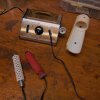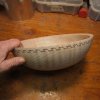Howdy Bill......
Yes, you got it! I want a nice solid black line, using a style of lettering borrowed from my Mother. I want it to have the look of hand-done, and that can only be had by a smooth flow of the pen. I know exactly what you and John are describing, but I'm also holding out for a solution, rather than taking someone else's advice that it won't work. It's possible I won't be able to overcome the difficulties.....and, if that happens, you and John are welcome to give me the "I told you so" treatment!

I haven't gone back to lettering, as of yet, but will do it eventually. (I have so many projects going on, that I'm feeling overwhelmed at times!) Anyway, I have an idea that if high heat is used along with no, none, zip, zero, nada downward pressure, the problems with softer/harder grain could be overcome. Now, this does present some problems, but I've got the idea that some mechanical means of stability could cross that bridge.......
Don't know.......but, for now, I'm on to other things.......

ooc












